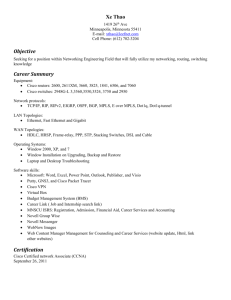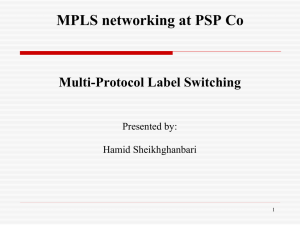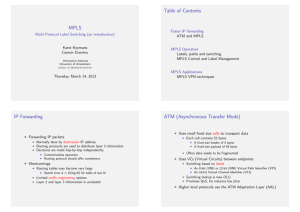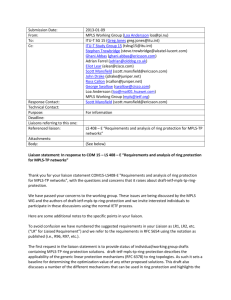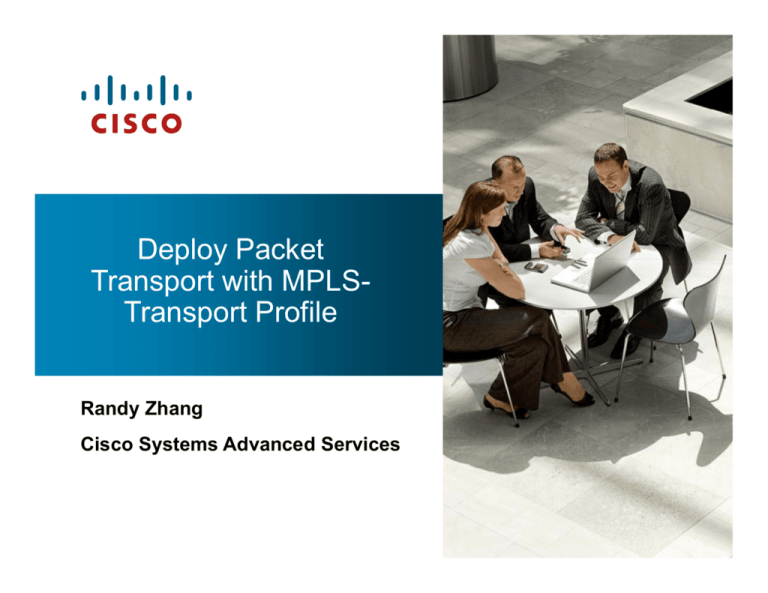
Deploy Packet
Transport with MPLSTransport Profile
Randy Zhang
Cisco Systems Advanced Services
Agenda
Transport
p Network Transformation
Why MPLS TP?
MPLS TP Technical Overview
Deployment Scenarios
MPLS TP Deployment Lifecycle
RZhang_MPLS_TP
© 2012 Cisco Systems, Inc. All rights reserved.
2
Transport Network
Transformation
RZhang_MPLS_TP
© 2012 Cisco Systems, Inc. All rights reserved.
3
What is Transport Network?
A network to provide a reliable aggregation and
transport infrastructure for any client traffic type
Oh um, please do it at the lowest cost per bit…
RZhang_MPLS_TP
© 2012 Cisco Systems, Inc. All rights reserved.
4
Specifically
Cost effective
Multi-service
Scalable
Quality of
service
Transport Network
RZhang_MPLS_TP
© 2012 Cisco Systems, Inc. All rights reserved.
5
Where Have We Been?
Looking back in our memory
for the past several decades
on network events that
affected
ff t d the
th transport
t
t network
t
k
RZhang_MPLS_TP
© 2012 Cisco Systems, Inc. All rights reserved.
6
Networks in the 1980s
1981: first IBM PC
1983: Novell, ISO OSI model, ARPANET runs on TCP/IP
y
, Cisco Systems
y
1984: IBM PC AT system,
1985: Standardization of Ethernet 10Base2, Sun Micro
NFS, IBM Token Ring
1987: Standardization of SONET, 10BaseT
1988: ATM cell format standardized
Top
p shows on TV were Dallas and The Cosby
y Show
RZhang_MPLS_TP
© 2012 Cisco Systems, Inc. All rights reserved.
7
Networks in the 1990s
1991: LAN switches
1992: Public frame relay service,100 Mbps Ethernet,
Windows 3.1
1994: GPS
1995: Cable modem, VOIP software
1997: Standardization of full duplex Ethernet
1998: Standardization of Gigabit Ethernet
Top
p shows on TV were Seinfeld,, ER
RZhang_MPLS_TP
© 2012 Cisco Systems, Inc. All rights reserved.
8
Transport Network Layers: 1980s – 1990s
O ti i d for
Optimized
f voice
i and
d TDM traffic
t ffi
IP Ethernet,
IP,
Eh
ATM,
ATM Frame
F
Relay
R l
SONET/SDH DSx
SONET/SDH,
RZhang_MPLS_TP
© 2012 Cisco Systems, Inc. All rights reserved.
9
Important Network Issues around 2000
TDM was the primary transport
Business dominated bandwidth
Client-server
Cli t
was the
th computing
ti model
d l
Internet-based voice applications began to be widespread
RZhang_MPLS_TP
© 2012 Cisco Systems, Inc. All rights reserved.
10
Significant Developments 2000 - Today
2001: standardization of G.709
G 709
2002: standardization of 10 GigE
2009:
2009 standardization
t d di ti off MPLS TP
2010: standardization of 40 GigE and 100 GigE, OTU4
RZhang_MPLS_TP
© 2012 Cisco Systems, Inc. All rights reserved.
11
Transport Network Layers: 2000s
R t fitti for
Retrofitting
f Data
D t
IP Ethernet
IP,
Eh
SONET/SDH DWDM,
SONET/SDH,
DWDM OTN
RZhang_MPLS_TP
© 2012 Cisco Systems, Inc. All rights reserved.
12
Important Network Issues around 2012
TDM transitioning to Ethernet
Consumer dominating bandwidth use
Peer-to-peer
P
t
computing
ti and
d cloud
l d computing
ti as th
the new
models
Internet-based video applications putting demand on
bandwidth
RZhang_MPLS_TP
© 2012 Cisco Systems, Inc. All rights reserved.
13
The Explosion of Bandwidth Demand
The world of
Warcraft players
Business video
Cloud
computing
HDTV
4G mobile and
wireless users
RZhang_MPLS_TP
Music and
video
download
© 2012 Cisco Systems, Inc. All rights reserved.
14
Bandwidth Availability
Moore’s Law: Computing
p
g
power doubles every 18
months
Nielsen’s Law: Bandwidth
growth for home users doubles
every 21 months
User experience
p
remains bandwidth-bound
RZhang_MPLS_TP
© 2012 Cisco Systems, Inc. All rights reserved.
15
Why Traditional Transport Is Limited?
Primary traffic type is now bursty data
SONET/SDH is capped at OC-768 (40 Gbps)
Traditional
T diti
l network
t
k iis b
based
d on TDM
TDM is expensive to operate
Co-existing of multiple transport networks are costly
RZhang_MPLS_TP
© 2012 Cisco Systems, Inc. All rights reserved.
16
Entering the Zettabyte Era
IP Traffic Growth
Internet
Video
Mobile
0.2 EB to 1.2 EB per Month
6x Increase from ‘10 to ’15
1 Exabyte = 109 Gigabyte
1 Zettabyte = 1000 Exabyte
Source: Cisco Visual Networking Index (VNI) Global IP Traffic Forecast, 2010–2015
RZhang_MPLS_TP
© 2012 Cisco Systems, Inc. All rights reserved.
17
Circuit to Packet Migration
2011
2013
2016
Private Line
TDM Traffic
Private Line
TDM Traffic
Private Line
TDM Traffic
~50-70%*
20-30%
Private/Public
IP Traffic
Private/Public
IP Traffic
Private/Public
IP Traffic
~30-50%
70-80%
90+%
90+% IP Traffic
0─10%
Legacy TDM
Traffic
Dramatic shift in SP traffic make-up in next 5 years
Network evolving
- Transformation: TDM to Packet
- Convergence: Collapse Layers; IP + Optical Convergence
SP revenue shifting from circuits to packet services
5 yrs ~80% revenue derived from packet services
Source: ACG Research 2011
RZhang_MPLS_TP
© 2012 Cisco Systems, Inc. All rights reserved.
18
Summary
y of Transport
p
Transformation
Drivers
Explosion of data traffic
Convergence of multiple networks into a single transport
network
Reducing CAPEX and OPEX
Provisioning agility and flexibility
RZhang_MPLS_TP
© 2012 Cisco Systems, Inc. All rights reserved.
19
Next Generation Transport
Packet will be the primary traffic type
Solutions to support packet will depend on cost
MPLS-TP
MPLS TP will
ill b
be th
the predominant
d i
t core ttransportt
technology
10/40/100 G DWDM and 10/40/100 G Ethernet on the
core
Circuit services will co-exist with p
packet services
RZhang_MPLS_TP
© 2012 Cisco Systems, Inc. All rights reserved.
20
Packet Optical Transport Components
OTN: a foundation technology for any service over WDM
Ethernet: a ubiquitous Layer 2 technology
MPLS-TP:
MPLS TP an emerging
i MPLS ttechnology
h l
th
thatt provides
id
carrier grade transport
MPLS Pseudowire: A circuit emulation technology based
on MPLS
RZhang_MPLS_TP
© 2012 Cisco Systems, Inc. All rights reserved.
21
Enabling Technologies
SONET/SDH
• Carrier class
• OAM&P
• QoS
Ethernet
• Lower cost
• Designed for
data
The new
MPLS
• Virtual circuit
• Widely
deployed
RZhang_MPLS_TP
© 2012 Cisco Systems, Inc. All rights reserved.
OTN
• CWDM and
DWDM
• G.709
22
A Converged Network
A single transport network based on WDM
OTN provides the digital wrapper
MPLS Transport
T
t Profile
P fil (TP) provides
id SONET like
lik
services
Ethernet technologies provide lower cost in CAPEX and
OPEX
Traditional TDM services and p
packet based services
carried over a single transport network
RZhang_MPLS_TP
© 2012 Cisco Systems, Inc. All rights reserved.
23
Why MPLS TP?
TP?
RZhang_MPLS_TP
© 2012 Cisco Systems, Inc. All rights reserved.
24
Motivation for MPLS TP
Evolution of SONET/SDH transport networks to packet
switching driven by
• Growth in packet-based services (L2/L3 VPN, IPTV, VoIP, etc)
• Desire for bandwidth/QoS flexibility
New packet transport networks need to retain same
operational model
MPLS TP, defined jointly between IETF and ITU-T,
provides the next step
RZhang_MPLS_TP
© 2012 Cisco Systems, Inc. All rights reserved.
25
Ethernet or MPLS Transport?
Ethernet
Lack of scalability, traffic engineering, fast protection, circuit
service support
MPLS
Well accepted by carrier as core IP/MPLS network
More mature carrier-oriented packet technology.
RZhang_MPLS_TP
© 2012 Cisco Systems, Inc. All rights reserved.
26
Transport Network Characteristics
Predetermined and long-lived connections
Emphasis on manageability and deterministic behavior
Fast fault detection and recoveryy ((sub-50 ms))
In-band OAM
RZhang_MPLS_TP
© 2012 Cisco Systems, Inc. All rights reserved.
27
MPLS Network Characteristics
Dynamically routed label switched paths
Traffic statistically multiplexed
Data p
plane setup
p and torn down based on dynamic
y
control plane
Optimized for a packet network
RZhang_MPLS_TP
© 2012 Cisco Systems, Inc. All rights reserved.
28
Converging MPLS and Transport
MPLS Transport
Profile
IP/MPLS
Widely deployed
Carrier grade
Multiservice
Connection oriented path
CAPEX and OPEX savings
g
Transport
Transport operational model
Static and dynamic
provisioning
Protection switching
triggered by data plane
IP-less transport OAM
functionality
y
Bidirectional path
RZhang_MPLS_TP
© 2012 Cisco Systems, Inc. All rights reserved.
29
Objectives of MPLS-TP
MPLS TP
To enable MPLS to be deployed in a transport network
and operated in a similar manner to existing transport
technologies (SDH/SONET/OTN)
To enable MPLS to support packet transport services
with a similar degree of predictability, reliability, and
OAM to that found in existing transport networks
MPLS TP is a subset of MPLS to meet transport network
operational requirements plus additional functionality based on
transport requirements
RZhang_MPLS_TP
© 2012 Cisco Systems, Inc. All rights reserved.
30
What is MPLS
MPLS-TP?
TP?
MPLS is bi-directional LSPs
MPLS-TP
No LSP merging
No ECMP (Equal-cost multi-path routing)
Does not support connectionless mode
Simple in scope,
scope less complex in operation
OAM/Data Fate sharing with congruent paths
Traffic and OAM must be congruent,
g
, achieved byy MPLS-TP
GAL, and generic ACH to carry OAM packets and enable
processing at intermediate nodes when required.
RZhang_MPLS_TP
© 2012 Cisco Systems, Inc. All rights reserved.
31
Summary of MPLS TP Characteristics
Connection-oriented packet switching model
No modifications to existing MPLS data plane
IP or IP routing is not required for packet forwarding
Interoperates/interworks with existing MPLS and
pseudowire control and data planes
RZhang_MPLS_TP
© 2012 Cisco Systems, Inc. All rights reserved.
32
Summary of MPLS TP Characteristics
Networks can be created and maintained using static
provisioning (management plane) or a dynamic control
plane
In-band OAM (congruent)
(
g
)
Protection options: 1:1, 1+1 and 1:N
Network operation similar to existing transport networks
RZhang_MPLS_TP
© 2012 Cisco Systems, Inc. All rights reserved.
33
MPLS-TP:
MPLS
TP: Transport like OAM
In-band OAM channels
Performance monitoring for SLA verification
Sub-path
p
monitoring
g with multi-level operation
p
Alarms and AIS
RZhang_MPLS_TP
© 2012 Cisco Systems, Inc. All rights reserved.
34
MPLS-TP:
MPLS
TP: Transport like Operation
Data plane / control plane independent
Transport path fully operational without control plane
Traffic engineered
g
p
path control
RZhang_MPLS_TP
© 2012 Cisco Systems, Inc. All rights reserved.
35
MPLS-TP:
MPLS
TP: Transport like Protection
Protection switching triggered by OAM
Linear protection
Ring
gp
protection
50 ms switchover
RZhang_MPLS_TP
© 2012 Cisco Systems, Inc. All rights reserved.
36
MPLS-TP Summary
Data Plane
Control/Management Plane
MPLS Bidirectional P2P and P2MP LSPs
No LSP merging
NMS provisioning option
PHP optional
ti
l
GMPLS control
t l plane
l
option
ti
GACh: Generic Associate Channel
PW control plane option
MPLS
Forwarding
GAL: Generic Associate Label
PW (SS
(SS-PW,
PW, MS
MS-PW)
PW)
MPLS Based
OAM
OAM
MPLS
P t ti
Protection
Resiliency
y
In-band OAM
Fault management:
Proactive CC/CV: BFD based
Ping and trace: LSP ping based
Alarm Suppression and Fault Indication
AIS, RDI, LDI, and CFI
Performance monitoring: Loss and Delay
RZhang_MPLS_TP
© 2012 Cisco Systems, Inc. All rights reserved.
Deterministic path protection
Sub-50ms switch over
1:1, 1+1, 1:N protection
Linear protection
Ring protection
37
MPLS-TP
MPLS
TP Standards
RFC 6423: Using the Generic Associated Channel Label for
Pseudowire in the MPLS Transport Profile (MPLS-TP)
RFC 5654: Requirements of an MPLS Transport Profile
RFC 5718: An In-Band Data Communication Network For the
MPLS Transport Profile
RFC 5860: Requirements for Operations, Administration, and
Maintenance ((OAM)) in MPLS Transport
p Networks
RFC 5951: Network Management Requirements for MPLS-based
Transport Networks
RFC 5960: MPLS Transport Profile Data Plane Architecture
RZhang_MPLS_TP
© 2012 Cisco Systems, Inc. All rights reserved.
38
MPLS-TP
MPLS
TP Standards
RFC 6370: MPLS Transport Profile (MPLS-TP) Identifiers
RFC 6426: MPLS On-Demand
On Demand Connectivity Verification and Route
Tracing
RFC 6378: MPLS Transport Profile (MPLS-TP) Linear Protection
RFC 6427: MPLS Fault Management Operations, Administration,
and Maintenance (OAM)
RFC 6428; Proactive Connectivity Verification
Verification, Continuity Check
Check,
and Remote Defect Indication for the MPLS Transport Profile
RFC 6435: MPLS Transport Profile Lock Instruct and Loopback
F
Functions
i
RZhang_MPLS_TP
© 2012 Cisco Systems, Inc. All rights reserved.
39
MPLS Transport
p
Profile (TP
(TP))
Technical Overview
RZhang_MPLS_TP
© 2012 Cisco Systems, Inc. All rights reserved.
40
MPLS Terminology Overview
Label Edge Router (LER)
Label Switch Router (LSR)
Label Switched Path (LSP)
LSP defines the path through LSRs from ingress to egress LER
A collection of label pushes, swaps and Pops
Can be defined in many different ways : statically, dynamically through LDP, BGP, RSVP
RZhang_MPLS_TP
© 2012 Cisco Systems, Inc. All rights reserved.
41
MPLS Label
0
1
2
3
0 1 2 3 4 5 6 7 8 9 0 1 2 3 4 5 6 7 8 9 0 1 2 3 4 5 6 7 8 9 0 1
Label
EXP
S
TTL
Label = 20 bits
EXP = Experimental bits or traffic class (TC), 3 bits
S = Bottom of Stack, 1 bit
TTL = Time to Live,, 8 bits
It can be used over a variety of L2 encapsulations.
Labels can be stacked
RZhang_MPLS_TP
© 2012 Cisco Systems, Inc. All rights reserved.
42
LSP Example
Out
Lab
In
Lab
Out
I/F
Out
Lab
In
Lab
Address
Prefix
Out
I/F
Out
Lab
21 172.68.2.2/32 Lo0 Pop
42
2
21
–
172.68.2.2/32
0
42
In
Lab
Address
Prefix
Out
I/F
3
1
2
0
LSP
PE
Lo0=172.68.2.2/32
Payload
RZhang_MPLS_TP
Data
PE
Lo0=172.68.1.2/32
P
21
Payload
© 2012 Cisco Systems, Inc. All rights reserved.
Data
42
Payload
Data
43
MPLS Pseudowire Terminology Overview
Provider Edge (PE)
Provider Router (P)
Pseudowire
Tunnel LSP
Provider Edge (PE)
Attachment
Circuit (AC)
Pseudowire used to provide a service over MPLS
Two levels of label stacking
Tunnel LSP: identifying the path from PE to PE
Pseudowire: identifying the pseudowire services
RZhang_MPLS_TP
© 2012 Cisco Systems, Inc. All rights reserved.
44
Pseudowire Example
Out
Lab
In
Lab
Out
I/F
Out
Lab
In
Lab
Address
Prefix
Out
I/F
Out
Lab
21 172.68.2.2/32 Lo0 Pop
42
2
21
–
172.68.2.2/32
0
42
In
Lab
Address
Prefix
Attachment Circuit
Out
I/F
3
1
2
0
Attachment Circuit
LSP
PE
Lo0=172.68.2.2/32
PE
Lo0=172.68.1.2/32
P
Attachment Circuit ID label = 1
Payload
Data
RZhang_MPLS_TP
21 1 Payload
Data
© 2012 Cisco Systems, Inc. All rights reserved.
42 1 Payload
Data
Payload
Data
45
MPLS TP Architecture
NMS for Network
Management Control
Working LSP
Client node
Client node
Provider Edge
Provider Edge
P t t LSP
Protect
MPLS-TP LSP (Static or Dynamic)
Section
Pseudowire
Section
with e2e and
segment OAM
Client Signal
Connection Oriented,, pre-determined
p
working
gp
path and p
protect p
path
Transport Tunnel 1:1 protection, switching triggered by in-band OAM
RZhang_MPLS_TP
© 2012 Cisco Systems, Inc. All rights reserved.
46
The Three Planes for MPLS
Control plane
Routing and Signaling: label distribution and LSP setup
Traffic Engineering: constrain based path computation, fast
reroute
Forwarding plane
Also called data plane: push, pop, swap
Responsible for actual data packet forwarding
Management plane
Configuration, provisioning, maintenance
RZhang_MPLS_TP
© 2012 Cisco Systems, Inc. All rights reserved.
47
MPLS TP Planes
Data plane is based on MPLS label forwarding
• Push: adding an outgoing label
• Pop: remove an incoming label
• Swap: replace the incoming label with an outgoing label
Data plane bandwidth must be enforced with QoS
plane is not required,
q
, with GMPLS optional
p
Control p
Interoperates/interworks with existing MPLS and
pseudowire control and data planes
Labeled switched path (LSP) may be setup via the
management plan
RZhang_MPLS_TP
© 2012 Cisco Systems, Inc. All rights reserved.
48
Management Plane for MPLS TP
NMS plays a central role in a transport network
space
DCN provides the critical management
infrastructure
Circuit provisioning and maintenance
Create and manage a LSP or PW across a
network
LSP establishment
LSP maintenance
Fault, PM reporting
RZhang_MPLS_TP
© 2012 Cisco Systems, Inc. All rights reserved.
49
MPLS TP Control Plane
A control plane is defined but not mandatory
GMPLS is an optional control plane for MPLS that can
dynamically set up LSPs in a transport network
An end to end control plane is also supported
Management and control planes may co-exist in the
same MPLS TP domain
RZhang_MPLS_TP
© 2012 Cisco Systems, Inc. All rights reserved.
50
MPLS TP LSP Characteristics
LSP is always bidirectional
An LSP is contained within a tunnel
Tunnel can be protected or unprotected
In-band OAM on each LSP
Working Protect
LSP
LSP
OAM
Channel
RZhang_MPLS_TP
OAM
Channel
MPLS-TP
T
Tunnel
l
Protected
© 2012 Cisco Systems, Inc. All rights reserved.
MPLS-TP
LSP
OAM
Channel
MPLS-TP
MPLS
TP
Tunnel
51
OAM
OAM packets co-routed with data packets (in-band) to
d t t data
detect
d t plane
l
faults
f lt
OAM available at LSP and PW levels
Working
LSP
OAM
Channel
RZhang_MPLS_TP
© 2012 Cisco Systems, Inc. All rights reserved.
Protect
LSP
OAM
Channel
MPLS-TP
Tunnel
Protected
52
Tunnel End Point
Tunnel holds a working
g LSP and optionally
p
yap
protect LSP
Working
Protect (optional)
Tunnel may be configured with a bandwidth allocation
Tunnel operationally up if at least one LSP operationally
UP (and not locked out)
LSP operationally up if OAM (Continuity Check) session
operationally
p
y up
p
RZhang_MPLS_TP
© 2012 Cisco Systems, Inc. All rights reserved.
53
Tunnel Mid-Point
Mid Point
LSP defined using LSP ID
Semantics of
source/destination only
g
locallyy significant
Configuration of forward
(from tunnel source) and
reverse (from
(f
tunnell
destination) LSP directions
MPLS TP
MPLS-TP
LSP
MPLS-TP
Tunnel
OAM
Channel
LSP
Direction
IInputt
Label
Output
O
t t
Label
Output
O
t t
Interface
Forward
323111
334111
Gi2/1
Reverse
343111
111
Gi2/4
RZhang_MPLS_TP
© 2012 Cisco Systems, Inc. All rights reserved.
Configuration of label
swapping (input label,
output label and output
i t f
interface)
)
54
OAM Channel
MPLS TP OAM channel is called MPLS Generic
A
Associated
i t d Ch
Channel,
l or GACh
GACh is identified by its header
The
Th ttype off channel
h
l is
i id
identified
tifi d b
by Ch
Channell T
Type
0 0 0 1 Version
RZhang_MPLS_TP
Reserved
© 2012 Cisco Systems, Inc. All rights reserved.
Channel Type
55
GACh for MPLS TP LSP
A well-known label is assigned for GACh (13)
A GACh Label (GAL) acts as an exception mechanism
to identify OAM packets
Label
GAL
G-ACH
OAM
Payload
RZhang_MPLS_TP
0 0 0 1 Version
13
TC 1
Reserved
Channel Type
© 2012 Cisco Systems, Inc. All rights reserved.
1
Generic Associated
Channel Label (GAL)
Associated Channel
Header
(ACH)
56
G-ACh Packet Structure for an MPLSTP LSP
Label
TC S
TTL
13
TC 1
1
Reserved
Channel Type
0 0 0 1 Version
Length
Reserved
TLV Type
Length
LSP Shim Header
Generic Associated Channel Label ((GAL))
Associated Channel Header (ACH)
ACH TLV Header
ACH TLV (e.g
(e g Source,
Source destination,
destination LSP Id,
Id PW Id)
Value
G-ACH Message
G-ACh Message
GAL as bottom of label stack
GAL only processed if LSP label popped or LSP TTL expires
Same ACH structure
RZhang_MPLS_TP
© 2012 Cisco Systems, Inc. All rights reserved.
57
OAM Functions
Function
Continuity Check
Connectivity Verification
Diagnostic Tests
Route Tracing
Lock Instruct
Lock Reporting
Alarm Reporting
Remote Defect Indication
Client Failure Indication
Packet Loss Measurement
Packet Delay Measurement
RZhang_MPLS_TP
Description
Checks ability to receive traffic
Verifies that a packet reaches expected node
General diagnostic tests (e.g. looping traffic)
Discovery of intermediate and end points
Instruct remote MEPs to lock path (only test/OAM
traffic allowed)
Report a server-layer lock to a client-layer MEP
Report a server-layer fault to a client-layer MEP
Report fault to remote MEP
Client failure notification between MEPs
Ratio of packets not received to packets sent
One-way / two-way delay (first bit sent to last bit
received)
© 2012 Cisco Systems, Inc. All rights reserved.
58
LSP 1:1 Protection
Bidirectional LSP
Working LSP
((Up,
p Active))
Working LSP
(Up, Active)
P1
PE1
PE2
Protect LSP
(Up, Standby)
Protect LSP
((Up,
p Standby)
y)
P2
RZhang_MPLS_TP
© 2012 Cisco Systems, Inc. All rights reserved.
P3
Bidirectional LSP
59
LSP Protection Switching with Fault
Working LSP
(Down, Standby)
Working LSP
(Down, Standby)
P1
PE1
PE2
Protect LSP
((Up,
p Active))
Protect LSP
(Up Active)
(Up,
P2
RZhang_MPLS_TP
© 2012 Cisco Systems, Inc. All rights reserved.
P3
60
LSP Reversion
Working LSP
((Up,
p Active))
Working LSP
(Up, Active)
P1
WTR timer
expired
WTR timer
expired
PE1
PE2
Protect LSP
(Up, Standby)
Protect LSP
((Up,
p Standby)
y)
P2
RZhang_MPLS_TP
© 2012 Cisco Systems, Inc. All rights reserved.
P3
61
LSP Connectivity Check with BFD
Bidirectional Forwarding Detection (BFD) is used to
actively detect LSP connectivity
BFD relies on regularly receipt of Hello messages
A loss of a certain (usually 3) consecutive Hello
messages will trigger BFD down. For example, a 3.3
ms Hello interval will allow 10 ms fault detection
An LSP only becomes active when BFD is configured
and it is in the up state
RZhang_MPLS_TP
© 2012 Cisco Systems, Inc. All rights reserved.
62
MPLS TP BFD Encapsulation
GACh
Tunnel label
4 bytes
GAL
4 bytes
0001 | Ver | Resv | Channel Type
BFD header
BFD packet label
GAL: 13
GACh header with channel type 0x7
RZhang_MPLS_TP
© 2012 Cisco Systems, Inc. All rights reserved.
63
LSP Protection Switching with BFD
Working LSP
(Down, Standby)
BFD Control
Detection Time
E i d
Expired
Working LSP
(Down, Standby)
P1
BFD Control
Detection Time
Expired
Switching time < 50 ms
PE1
PE2
Protect LSP
((Up,
p Active))
Protect LSP
(Up Active)
(Up,
P2
RZhang_MPLS_TP
© 2012 Cisco Systems, Inc. All rights reserved.
P3
64
LSP Fault Detection with LDI
LSP has fault detection built in
A fault detected on any point of the LSP will cause the
immediate nodes to generate LDI (Link Down
Indication)) messages
g and LOS
LSP end points will process LDI messages and trigger
LSP down action
LSP end points will then generate RDI messages
LSP is taken down on both directions
RZhang_MPLS_TP
© 2012 Cisco Systems, Inc. All rights reserved.
65
MPLS TP Fault OAM
GACh
Tunnel label
4 bytes
GAL
4 bytes
0001 | Ver | Resv | Channel Type
Fault OAM header
Fault OAM message types:
AIS Alarm Indication Signal
LDI Link Down Indication
LKR Lockout
Fault OAM packet label
GAL: 13
GACh header with channel type 0x58
RZhang_MPLS_TP
© 2012 Cisco Systems, Inc. All rights reserved.
66
LSP Protection Switching with Fault
OAM
LDI
Working LSP
(Down, Standby)
LOS
P1
PE1
PE2
Protect LSP
((Up,
p Active))
Protect LSP
(Up Active)
(Up,
P2
RZhang_MPLS_TP
Working LSP
(Down, Standby)
© 2012 Cisco Systems, Inc. All rights reserved.
P3
67
LSP Lockout
An LSP can be administratively locked out
A locked out LSP does not carry traffic
RZhang_MPLS_TP
© 2012 Cisco Systems, Inc. All rights reserved.
68
LSP Protection Switching with Lockout
LKR
Working LSP
(Up, Standby)
LKR
P1
PE1
PE2
Protect LSP
((Up,
p Active))
Protect LSP
(Up Active)
(Up,
P2
RZhang_MPLS_TP
Working LSP
(Up, Standby)
© 2012 Cisco Systems, Inc. All rights reserved.
P3
69
Mapping of Customer Traffic
Customer traffic connected via an Attachment Circuit
(AC)
An AC cross connected to an MPLS virtual circuit (VC)
or pseudowire
p
A VC can be point to point or multipoint
RZhang_MPLS_TP
© 2012 Cisco Systems, Inc. All rights reserved.
70
Pseudowire Reference Model
Emulated Service
Pseudowire
PSN
Tunnel
Native
Service
Native
Service
PW1
CE
AC
AC
PE
PW2
PE
AC
CE
AC
CE
CE
An Attachment Circuit
Circ it (AC) is the ph
physical
sical or virtual
irt al circ
circuit
it
attaching a CE to a PE
Customer Edge (CE) equipment perceives a PW as an
unshared link or circuit
RZhang_MPLS_TP
© 2012 Cisco Systems, Inc. All rights reserved.
71
Virtual Private Wire Service (VPWS)
A point to point circuit that emulates a line
If Attachment Circuit (AC) is a physical port, Ethernet
Private Line
If AC is sharing the port with other ACs,
ACs Ethernet Virtual
Private Line
RZhang_MPLS_TP
© 2012 Cisco Systems, Inc. All rights reserved.
72
Pseudowire Redundancy
Second layer of redundancy in addition to MPLS-TP
LSP 1:1 Protection
Protected pseudowires are in Active/Standby states
Standby pseudowire is down
down, pseudowire label is
released
RZhang_MPLS_TP
© 2012 Cisco Systems, Inc. All rights reserved.
73
MPLS-TP
MPLS
TP Pseudowire Redundancy
Active Pseudowire
AC
LSP
Source
LSP
Destination
Working LSP 1
AC
TP Tunnel 1
TP Tunnel 1
Protect LSP 1
MPLS
Encap
MPLS
Encap
Working LSP 2
TP Tunnel 2
TP Tunnel 2
T-PE
Protect LSP 2
Standby Pseudowire
T-PE
LSP 1:1 Protection
Pseudowire Protection
RZhang_MPLS_TP
© 2012 Cisco Systems, Inc. All rights reserved.
74
Virtual Private LAN Service
A multipoint circuit that emulates a LAN
If AC is a physical port, Ethernet Private LAN
If AC is sharing the port with other ACs, Ethernet Virtual
Private LAN
RZhang_MPLS_TP
© 2012 Cisco Systems, Inc. All rights reserved.
75
VPLS Redundancy
All PEs of the same private LAN are fully meshed
Split horizon is enabled
A protected MPLS TP LSP makes fiber fault
transparent to VPLS
RZhang_MPLS_TP
© 2012 Cisco Systems, Inc. All rights reserved.
76
Bandwidth Management
MPLS-TP LSPs can reserve bandwidth (for tunnel provisioning)
LSP bandwidth reservation configured explicitly at each hop
MPLS-TP LSPs have highest setup/hold priorities
Data plane bandwidth enforcement requires QoS configuration
MPLS-TP LSP
Data link
RZhang_MPLS_TP
© 2012 Cisco Systems, Inc. All rights reserved.
77
Data Plane QoS
Traffic type classification based on CoS, IP Prec/DSCP, VLAN etc
End-to-end bandwidth provisioning and guarantee
Low latency queuing for delay or jitter-sensitive traffic
Prioritizing processing of control or management-plane traffic over
data-plane traffic
RZhang_MPLS_TP
© 2012 Cisco Systems, Inc. All rights reserved.
78
MPLS TP
Deployment
Scenarios
RZhang_MPLS_TP
© 2012 Cisco Systems, Inc. All rights reserved.
79
Common Deployment Scenarios
Migration of SONET/SDH to MPLS-TP
Consolidation into a single transport network
Greenfield deployment that requires SONET like
protection
Multipoint LAN services over transport
Deployment
D l
tE
Examples:
l
Metro aggregation/access
Mobile back
back-haul
haul
RZhang_MPLS_TP
© 2012 Cisco Systems, Inc. All rights reserved.
80
Common Deployment Practices
LSPs are provisioned by NMS without a control plane
BFD processed in hardware for 10 ms fault detection
VPWS for point to point EPL or EVPL services
Dual home pseudowires for site protection
VPLS for multipoint services such as multicast video
di t ib ti
distribution
Use of QoS for preferential services and
oversubscription
RZhang_MPLS_TP
© 2012 Cisco Systems, Inc. All rights reserved.
81
Consolidation and Simplification
Currently multiple networks for TDM and packet
Consolidate into a single transport network
SONET like timing provided via Synchronous Ethernet
T1/E1, Ethernet, STM1
Business
Packet Transport
with MPLS TP
T1/E1 Ethernet,
T1/E1,
Ethernet OCn/STMn
Corporate
GE
RZhang_MPLS_TP
© 2012 Cisco Systems, Inc. All rights reserved.
Synchronous Ethernet timing
82
FTTx Deployment
Aggregation of Ethernet services
50 ms protection for mission critical services
QoS for preferential delivery treatment
Use of satellite boxes to increase density and reach
FTTB
Packet Transport
with MPLS TP
Business
Set-Top-Box
CPE
FTTH
Tenant
Metro Ethernet
RZhang_MPLS_TP
© 2012 Cisco Systems, Inc. All rights reserved.
Protected or
unprotected TP
t
tunnels
l
83
FTTx Deployment Alternate
Use a ring of satellite boxes to reduce fiber usage
FTTB
Business
FTTH
Packet Transport
with MPLS TP
Set-Top-Box
CPE
Tenant
Metro Ethernet
RZhang_MPLS_TP
© 2012 Cisco Systems, Inc. All rights reserved.
Protected or
unprotected TP
t
tunnels
l
84
Mobile Backhaul Deployment
Migration of TDM to packet transport
50 ms protection
SONET like timing provided via Synchronous Ethernet
UMTS
Node B
GSM/GPRS/
EDGE BTS
GSM
BTS
TDM
N d Ra
Node
Ethernet
Packet Transport
with MPLS TP
Synchronous Ethernet timing
RZhang_MPLS_TP
© 2012 Cisco Systems, Inc. All rights reserved.
85
Central Office Fiber Management
Use of satellite boxes to reduce fiber management at
CO
FTTH
Access
PON
Access
CO
Ethernet
Access
CO
CO
Passive
Splitter
Home-Run from
CO to each user
Pro: Fiber Consolidation
Con: BW Constrained
RZhang_MPLS_TP
Pro: Bandwidth Scale
Con: Fiber Mgt.
g space
p
overhead in CO
© 2012 Cisco Systems, Inc. All rights reserved.
Home-Run from
CO to each user
Pro: Fiber Consolidation
Pro : Bandwidth Scale
86
Multipoint LAN Services
Virtual LAN services over MPLS TP transport
Multicast video distribution services
Enterprise LAN
Enterprise
p
LAN
R id ti l
Residential
Packet Transport
over DWDM
POP
POP
Residential
Residential
RZhang_MPLS_TP
© 2012 Cisco Systems, Inc. All rights reserved.
87
MPLS-TP
MPLSDeployment
Lifecycle
y
RZhang_MPLS_TP
© 2012 Cisco Systems, Inc. All rights reserved.
88
From TDM Transport to Packet
Transport
Know the differences
Understand the new requirements
Proof of concept testing
Create designs
Performance testing
Turn-up and provisioning
Follow a lifecycle process to ensure deployment
success and timely delivery
RZhang_MPLS_TP
© 2012 Cisco Systems, Inc. All rights reserved.
89
TDM Transport vs Packet Transport
Time division multiplexing vs statistical multiplexing
New terminologies and technologies: LSP, pseudowire,
BFD, VPWS, VPLS, QoS, policing, queuing
Provisioned bandwidth vs data plane QoS
Staff training
RZhang_MPLS_TP
© 2012 Cisco Systems, Inc. All rights reserved.
90
Creating Technical Requirements
Convert business requirements into technical
requirements
Identify QoS requirements for circuit emulating traffic
Generate topologies
Document traffic flows
Prioritize
P i iti requirements
i
t
RZhang_MPLS_TP
© 2012 Cisco Systems, Inc. All rights reserved.
91
Proof of Concept Testing
Convert technical requirements into a basic design
Convert topologies into a test lab
Validate the concept
Focus on general functionality and mandatory
requirements
RZhang_MPLS_TP
© 2012 Cisco Systems, Inc. All rights reserved.
92
Design
Generate a high level design based on proof of concept
testing
Understand traffic flow patterns
Identify MPLS TP parameters
Identify MPLS virtual circuit characteristics
Document
D
t network
t
k managementt
Specify scalability limits
RZhang_MPLS_TP
© 2012 Cisco Systems, Inc. All rights reserved.
93
QoS
Identify circuits that require SONET-like protection
The network can support both protected and
unprotected circuits
Design QoS policies to support all types of circuits
Identify circuits that require dual-homing
RZhang_MPLS_TP
© 2012 Cisco Systems, Inc. All rights reserved.
94
QoS Design Examples
Traffic are classified into TDM type circuits and packet
type circuits
For TDM type circuits:
No oversubscription
Priority queue (CoS 6)
Timing may be required
For p
packet type
yp circuits:
Oversubscription allowed
Weighted fair queues
Guaranteed Bandwidth for different queues
q
High (CoS 5)
Medium (CoS 3)
Low (Cos 0)
RZhang_MPLS_TP
© 2012 Cisco Systems, Inc. All rights reserved.
95
Performance Testing
A detailed verification of each type of traffic in the
design
Focus on protection switching and QoS
Document test case results and solutions
Update the design based on test results
RZhang_MPLS_TP
© 2012 Cisco Systems, Inc. All rights reserved.
96
Turn-up
Turn
up and Provisioning
Equipment install and turn-up
An intermediate staging may be useful
Operational staff training
Final hardware testing
Provision the equipment based on the design
The network is ready for use
RZhang_MPLS_TP
© 2012 Cisco Systems, Inc. All rights reserved.
97
Summary
RZhang_MPLS_TP
© 2012 Cisco Systems, Inc. All rights reserved.
98
Transport Network in a Transition
Explosion of data traffic
Convergence of multiple networks into a single transport
network
Reducing CAPEX and OPEX
Provisioning agility and flexibility
RZhang_MPLS_TP
© 2012 Cisco Systems, Inc. All rights reserved.
99
A Converged Transport
A single transport network based on WDM
OTN provides the digital wrapper
MPLS Transport
T
t Profile
P fil (TP) provides
id SONET like
lik
services
Ethernet technologies provide lower cost in CAPEX and
OPEX
Traditional TDM services and p
packet based services
carried over a single transport network
RZhang_MPLS_TP
© 2012 Cisco Systems, Inc. All rights reserved.
100
Why MPLS Transport Profile?
Transport like protection
Transport like OAM
Transport
p like operation
p
Statistical multiplexing and oversubscription
Interoperability with IP/MPLS
RZhang_MPLS_TP
© 2012 Cisco Systems, Inc. All rights reserved.
101
Follow the Deployment Process
Know the differences between TDM and packet
Understand new requirements
Proof of concept testing
Create designs
Performance testing
Turn-up and provisioning
RZhang_MPLS_TP
© 2012 Cisco Systems, Inc. All rights reserved.
102


